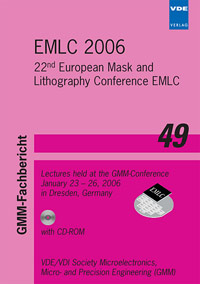Printability study with polarization based AIMS(TM) fab 193i to investigate mask polarization effects
Conference: EMLC 2006 - 22nd European Mask and Lithography Conference
01/23/2006 - 01/26/2006 at Dresden, Germany
Proceedings: EMLC 2006
Pages: 5Language: englishTyp: PDF
Personal VDE Members are entitled to a 10% discount on this title
Authors:
Zibold, Axel; Stroessner, Ulrich; Schmid, Rainer; Scherübl, Thomas; Rosenkranz, Norbert; Harnisch, Wolfgang (Carl Zeiss SMS GmbH, Carl Zeiss Promenade 10, 07745 Jena, Germany)
Poortinga, Eric (Carl Zeiss SMT Inc., Thornwood, 10594 NY, USA)
Abstract:
Immersion lithography offers the semiconductor industry the chance to extend the current ArF processes to smaller nodes before switching to a shorter wavelength. The move to immersion will require increased attention to the photomask along with new effects influencing the aerial image formation as the numerical apertures (NA) of scanners move up to at least 0.93 and even higher. Feature sizes on the photomask become comparable or even smaller than the wavelength and hence act more like wire grid polarisers which lead to polarisation effects. As of today AIMS(TM) fab tools are in operation worldwide. The novel AIMS(TM) fab 193i tool with a maximum NA of 0.93 is the latest aerial image measurement system for ArF-lithography emulation down to the 65nm node. Common adjustments are numerical aperture, illumination type and partial illumination coherence to match the conditions in 193nm scanners. In addition to non-polarized illumination, the AIMS(TM) fab 193i allows the user to select linear x and y polarised light for different settings and types, e.g. off-axis annular, quadrupole or dipole illumination. In this paper the polarisation effects of different photomask features are explored by comparing measurement results using linear polarised illumination parallel and perpendicular to line and space patterns and non-polarised illumination. Different MoSiON embedded phase shift masks have been investigated at the highest possible NA=0.93 and for different half-pitches from 500nm to 260nm, the latter corresponding to the 65nm node at the wafer level.


